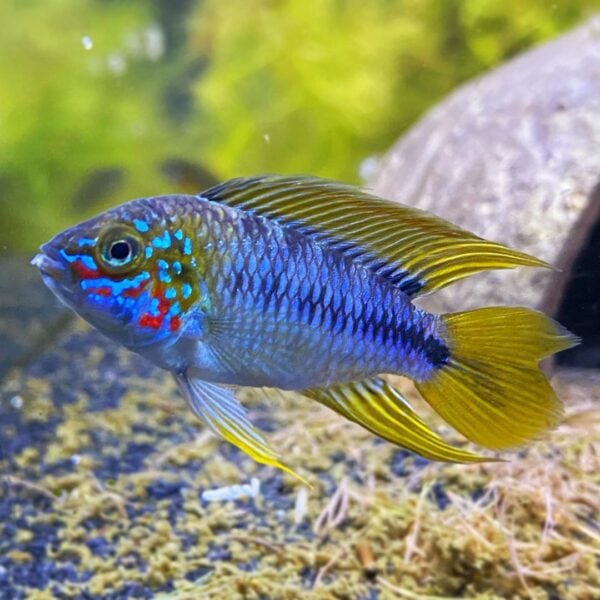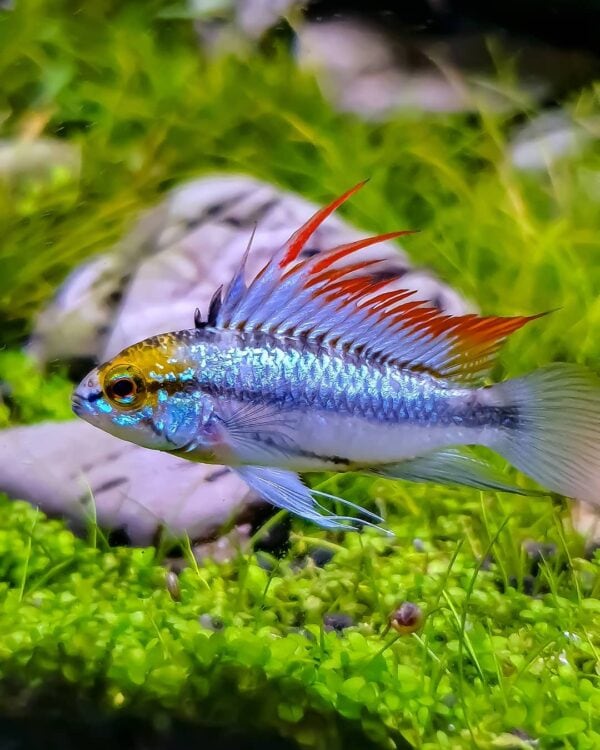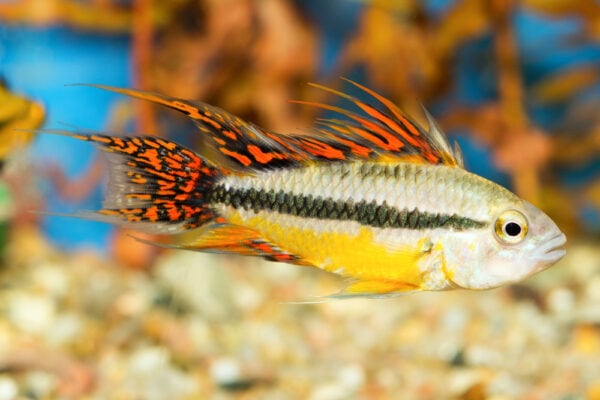Wouldn’t it be nice to be able to add a quick-swimming little splash of color to your aquarium? The apistogramma genus is a freshwater fish genus that belongs to the large family Cichlidae, and it is a type of dwarf cichlid that does well in most properly conditioned tanks. Their popularity is now on the rise again after a time of having somewhat fallen off the charts, and aquarium owners suddenly appear to be rediscovering these interesting looking and peaceful breeds. Dwarf cichlids are colorful, they have a big personality and they can make any tank seem even more exotic than it did before. Dwarf chichlids are found in South America, with some species appearing to only live in secluded and very exclusive areas.
Before you decide to incorporate a breed like this and one of the species that belong to the apistogramma genus, there are a few things to know. Every aquarium is different, and this guide will hopefully make it easier for you to decide whether an apistogramma is right for your fish tank.
Table of Contents
Basic Information
There are many things to consider, such as what type of tank you have, if you have males or females living in the water, the size of the aquarium, and more, and the best way to figure out if an apistogramma is for you is to know more about it. You will also need to decide which apistogramma species to go with, such as the apistogramma agassizii or the apistogramma cacatuoides, but the first step is to gain basic knowledge of the genus. Below is a quick introduction:
| Information Chart | Apistogramma |
|---|---|
| Care Level: | Intermediate to hard |
| Temperament: | Peaceful or low-level aggressive |
| Color: | Variating depending on species, with colored top, bottom, and tail fins. |
| Lifespan: | 5-10 years |
| Size: | 0.8-3.1 inches |
| Family | Cichlidae |
| Diet: | Live food and small animals |
| Minimum Tank Size: | 20 gallons of water |
| Temperature: | 72-86 degrees Fahrenheit |
| Water Conditions: | Neutral PH |
| Tank Mate Compatibility | Other apistogramma fish |
It is crucial to read up on any type of fish you plan to add to your aquarium, as not all fish get along well and every type of species requires different things, but and while the apistogramma is not the easiest to care for out of all breeds, it also isn’t the most difficult, and it only requires that you know a few basic things about the fish before you decide to get one (or preferably several, as they prefer to live with other fish).
Background
These fish are not ideal for beginners and for those with little experience caring for fish and an aquarium, as they require a bit more than some other species and fish genus. This, however, shouldn’t stop you if you are serious about making dwarf cichlids part of your fish collection, as they are well worth the extra trouble. Coming from areas scattered all over South America, these fish are threatened by deforestation in the wild, but they are surprisingly resistant when kept in a tank. One great thing about them is their personality, and how different they can be personality-wise even though they are from the same genus and even the same species!
Dwarf cichlids are found in a tropical climate, in the eastern regions of the Andes, and many species are known to live in for example Brazil. This is something you will want to keep in mind when bringing apistogramma fish into your tank, as they tend to do best if you try to recreate the conditions in which they would live in the wild. The apistogramma is overall an affordable type of fish, and you can expect to pay something between $11-13 for a fish in a pet store.
Appearance
Generally speaking, these fish are colorful and eye-catching, but the colors differ depending on whether the fish are male or female, and also on the type of species and/or breed. While there individual breeds can be quite easily distinguished, they are all also similar, and you can quickly tell that you are dealing with an apistogramma. The males are more colorful than the females, meaning there is a clear difference in appearance between the two sexes, and this can be helpful when wanting to breed cichlids. When compared to other cichlids, the dwarf cichlid (as the name indicates) is significantly smaller, which is great for tanks with reduced space. That said, for the apistogramma to grow to its full size and thrive, it needs adequate space in the water.
The easiest way to explain what an apistogramma can be expected to look like is by explaining some of the most common species individually:

Apistogramma borellii
One of the more subtly colored apistogramma fish is the apistogramma borellii, and it has fins that are light yellow – lemon colored some call them, and a pale light blue body with small randomly placed spots. This delicate fish is also known as an umbrella cichlid.

Apistogramma trifasciata
This tri-colored fish is quite the beauty! It gets its name from the three stripes that run horizontally down its silver-colored body, and the blue-colored fins create a gorgeous contrast that will inevitably draw some attention to it. It is the perfect addition to a tank that needs something extra, and one of the prettiest apistogramma fish species.

Apistogramma cacatuoides
Here we have the apistogramma fish species that is currently the most popular breed across the globe, and it is not hard to understand why when you see it. It has an impressive color with bright orange speckled fins and horizontal stripes, and you can also find a red version of the same species! This is an interesting twist, as the “Super Red” apistogramma cacatuoides has a very characteristic look, and there is something almost racecar-like about it as it swims through the water.
Behavior
Dwarf cichlids are fun fish to have, as they are very curious and outgoing, in contrast to other fish species that may be shy and hide most of the time. The cichlid swims around, investigates, swims up to the glass to see what is going on in the outside world and you are likely to see a lot of them when you have these fish in your aquarium. They tend to be very peaceful and mellow, rarely looking for trouble unless you have too many fish in your tank with not enough places to hide. Females don’t usually cause problems, but too many males of this species together – with insufficient vegetation to hide away in – could be an issue.
You should also expect different species to have somewhat differentiating behaviors, and due to their large personalities, even fish from the same species can often be more or less curious, with other personality quirks. If you are looking for fish that can easily live in harmony with others, and one you can add to your tank and that will make it brighter and colorful in an instant – the dwarf cichlid is the right one for you.
Apistogramma Tank Conditions
You may want to make sure to have a tank that holds at least 20 gallons of water, as this is believed to be the ideal conditions for dwarf cichlids, and the PH should be kept to normal with no need for lower PH levels. Considering there are over 90 different types of apistogramma fish, it is hard to say exactly how one prefers to live, but in the wild, they will generally live in shallow waters where there are plenty of hiding spaces such as plants and small caves. With this in mind, condition your aquarium with large dense plants, shells, hollow rocks, and more for your dwarf cichlids to use when needing some time to themselves. The ideal water temperature is somewhere in the range of 72-86 degrees Fahrenheit.
It seems that real and live plants are what the dwarf cichlid prefers, so if you plan to have dwarf cichlids in your aquarium then it is a good idea to skip the plastic plants and add real and love ones for the males and females of this breed to enjoy. Indian almond leaves are supposedly beneficial for making the fish feel right at home. This is a type of fish where the tank conditions matter, not necessarily for their survival, but for them to thrive and enjoy life living in your aquarium.
Plant Examples Suitable for Cichlids
- Ceratopteris thalictroides
- Flame moss
- Java fern
- Java moss
- Helanthium tenellum
- Water sprite
- Cryptocoryne
A sand substrate is the best material to line the aquarium with, and it is also a cheap material that is easily accessible in pet stores and online. Give your cichlids sand, plants, rocks, shells, and caves and appropriate tank mates, and you will be setting both yourself and your fish up for success.
Apistogramma Maintenance and Care
It is a good idea to keep a LED light over the aquarium, as these do not make it overly hot, and still provides the plants in the tank with enough light to thrive. The cichlid does not necessarily require light, but they are dependent on the vegetation and plants, and this is why adequate lighting is relevant.
Cichlids need live food and nutrition – they are opportunistic feeders that enjoy catching their own dinner in the water, and brine shrimp is a great way to reward your tiny swimmers a day or two a week. Other than brine shrimp, small animals, worms and other live food will also help keep your fish healthy and happy, and a happy fish is more likely to be its curious self – spreading joy both in its tank and in the home where the tank is kept.
Other than that, keep the water clean and fresh, remove any plants that look like they are rotting, and keep a good mix of fish that get along. Proper tank care is always important if you want your dwarf cichlids to live the 5-10 years that they can live when properly cared for, and this includes everything from food to water conditions.
Apistogramma Suitable Tank Mates
It is always a good option to place dwarf cichlids with other apistogrammas, as they tend to get along very well with others. One male will often surround itself with four, five, or even six females, so keep this in mind when planning for how many male and female apistogrammas to get. Being as social as they are, this is how they would live in the wild, and as mentioned above, it is crucial to mimic their natural living conditions when wanting to create a good environment for this brine shrimp living breed.
As long as there are enough food and hiding places, they will also do very well together with a number of other breeds, and they are compatible with rasboras, neon tetras, pencilfish, pygmy cories, blackskirt tetras, cardinal tetras and otocinclus catfish, among others. Try to make sure that all tank mates are more or less the same size, as the apistogramma can easily become prey to larger and more aggressive breeds. You will also benefit from avoiding any breeds with a tendency to nip at the fins of other tank inhabitants, as this could cause serious damage to the fins of the apistogramma.
Breeding Apistogramma
This beautiful aquatic animal is surprisingly easy to breed, which is good news for anyone who was planning on getting a pair to start breeding. One thing to be aware of, especially for beginners, is that movement in the water may disturb the process, so you might want to consider investing in a baffle that can be temporarily added to the filter. You also need to make sure you have both a male and a female in your tank, and preferably several females as this is how the apistogrammas will breed in the wild.
Setting Up the Tank
Some prefer to breed their apistogrammas in the main tank by basically letting them take care of the process themselves, but if this is what you feel the most comfortable with – don’t forget that you need to manually move the fry over to a separate breeding tank when the time comes, or you run the risk of another tank inhabitant eating them before they get a chance to grow. This may not be necessary if you only have dwarf cichlids in your tank, as the female inhabitants tend to be perfectly capable to defend their fry.
The other option would be to move a bonded pair over to a separate breeding tank ahead of time, to give them the privacy to go through the process, while also having a safe space for the fry to go through the critical growth stages. The setup in the breeding tank, in terms of water, food, plants, and shelter, is very similar to the main tank care requirements and conditions, and you should always make sure to have the tank ready first, as a first step in the breeding process.
Quick Guide
Some of these apistogrammas prefer a slightly warmer water temperature when breeding, so that would be the only potential change you will want to implement when preparing the water in the breeding tank. Place only one male with either one female or several females (depending on whether there is a bonded pair), and monitor the water conditions closely throughout the process. Some recommend changing approximately 10% of the water every day, as this will keep it as fresh and clean as possible, and to disturb the water as little as possible other than this. Females will become more yellow in color when they are ready for breeding, and you need to be sure you can separate the more colorful males from the females, or your breeding will be unsuccessful for obvious reasons.
The fry will be cared for by their mother until they are approximately 4 weeks old, and they should be kept separate from the main tank until they reach maturity.
FAQ (Frequently Asked Questions)
Are apistogrammas aggressive?
The apistogrammas are not known for being aggressive and are normally considered a very peaceful type of aquarium inhabitant. That said, rivalry and territorial behavior may occur, so ensure you have enough plants, hiding spots, and females in the tank.
Are the apistogrammas community fish?
Yes, they can be, but you should attempt to match them with similar types of genuses, as the apistogrammas are small and peaceful, and likely to become prey otherwise.
How big do apistogrammas get
Sizewise, these tend to grow to become up to a little over 3 inches at most.
Can apistogrammas be kept alone?
They can, but will not thrive. For the apistogrammas to be happy, it needs suitable tank mates, and males should ideally have multiple female apistogrammas around.
Conclusion
To sum this up, caring for apistogrammas is not necessarily hard, provided you have read through and understood their needs as a genus. They are fun, beautifully colored, and ideal for living in a community tank with the right tank mates, and you will notice how their personalities almost seem to rub off on their tank mates, creating an overall more harmonious atmosphere.
